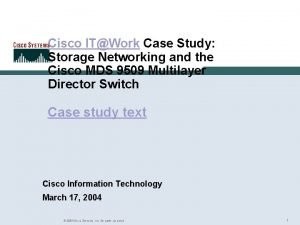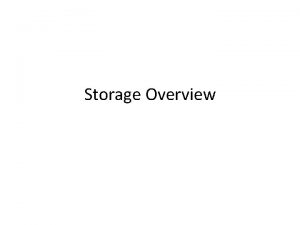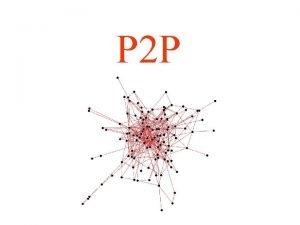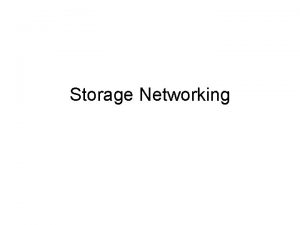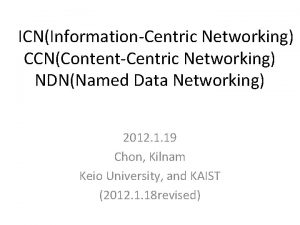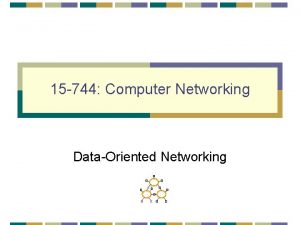Storage Networking Storage Trends Storage growth Need for




























- Slides: 28

Storage Networking

Storage Trends • Storage growth • Need for storage flexibility • Simplify and automate management • Continuous availability is required

Storage considerations • • Capacity Performance Scalability Availability and Reliability Backup and recovery requirements Support/staff needs Budget

File System Functions • Local FS: FAT, FAT 32, NTFS, HFS, etc. • A file system consists of structures for storing and managing data • Maintaining directories (folders) and file names • Tracking where each file is physically stored on the disk

File system

Block-level vs File-level access • File systems 2 views: 1. Data representation to users/applications (hierarchical view) 2. Storage organization (data structure) • Block-level access: write/read blocks; master/slave relationship • File-level access: using file names; client/server relationship

RAID • Consolidate multiple physical disks into a logical grouping • Designed for fault tolerance and performance improvement • Can be implemented in H/W or S/W • Several RAID levels exist

Hardware RAID • Volume Management performed by RAID controller • Parity computation performed by the RAID controller – decreases server overhead • Dedicated cache memory improves server performance

Software RAID • Performed by the server O/S • Parity computation performed by the server – increased overhead • RAID performance depends on the server performance and CPU load • For simple environments with lower performance and availability requirements

Simple levels of RAID • RAID 0 – Striping • RAID 1 – Mirrored Volumes • RAID 2 – Bit-level striping with parity distributed to one or more disks • RAID 3 – Byte-level striping with dedicated parity disk • RAID 4 – Block-level striping with dedicated parity disk • RAID 5 – Block-level striping with distributed parity • RAID 6 – Block-level striping with distributed double parity

RAID 0

RAID 5

RAID 1

Nested RAID • RAID 0+1: striped sets in a mirrored set • RAID 10 (or RAID 1+0): mirrored sets in a striped set • RAID 5+1: mirrored striped set with distributed parity (also known as RAID 53) • RAID 5+0: striped set of RAID-5 sets

DAS Block-level access File system is on the server SCSI protocol

DAS

NAS File-level access to the outside; block-level to the storage subsystem File system is on the NAS device Clients IP Network File Protocol: SMB/CIFS, NFS, etc. Servers

NAS

SAN Block-level access File system is on the server Storage Area Network SCSI over Fibre Channel Servers

SAN

SAN • Traditional SANs used Fibre Channel protocol and storage technology to connect SAN at gigabit speeds • SCSI commands transmitted over FCP • Expensive • Requires dedicated network equipment/architecture

IP Storage • As an alternative, existing IP infrastructure can be used • FCIP, i. FC protocols allow Fibre Channel devices to be connected over IP networks • i. SCSI allows SCSI commands to be encapsulated to be transferred through an IP network

i. SCSI • Allows SAN utilize TCP/IP for block-level data transfer • Transport for SCSI commands • Existing networks (routers/switches) can be utilized – no need for special equipment • With current network technologies supporting gigabit speeds, comparable to FC in speed




NAS-SAN Integration

Distributed File Systems • SMB/CIFS; Samba (Windows-based systems) • NFS (Unix-based) • AFS (Unix) • AFP (MAC) • NCP (Netware)
 Sdn and traditional networking
Sdn and traditional networking Economic growth trends
Economic growth trends Cisco storage networking
Cisco storage networking Network storage types
Network storage types Geometric exponential growth
Geometric exponential growth Carothers equation
Carothers equation Neoclassical growth theory vs. endogenous growth theory
Neoclassical growth theory vs. endogenous growth theory Primary growth and secondary growth in plants
Primary growth and secondary growth in plants Organic growth vs inorganic growth
Organic growth vs inorganic growth Plant growth index
Plant growth index Primary growth and secondary growth in plants
Primary growth and secondary growth in plants Shoot system
Shoot system Data storage growth
Data storage growth Tack för att ni lyssnade
Tack för att ni lyssnade Mall debattartikel
Mall debattartikel En lathund för arbete med kontinuitetshantering
En lathund för arbete med kontinuitetshantering Tobinskatten för och nackdelar
Tobinskatten för och nackdelar Atmosfr
Atmosfr Vad är vanlig celldelning
Vad är vanlig celldelning Programskede byggprocessen
Programskede byggprocessen Kraft per area
Kraft per area Presentera för publik crossboss
Presentera för publik crossboss Rbk mätning
Rbk mätning Formuö
Formuö Densitet vatten
Densitet vatten Kung som dog 1611
Kung som dog 1611 Nationell inriktning för artificiell intelligens
Nationell inriktning för artificiell intelligens Tack för att ni har lyssnat
Tack för att ni har lyssnat Smärtskolan kunskap för livet
Smärtskolan kunskap för livet


